#NebulaMagic
Explore tagged Tumblr posts
Photo


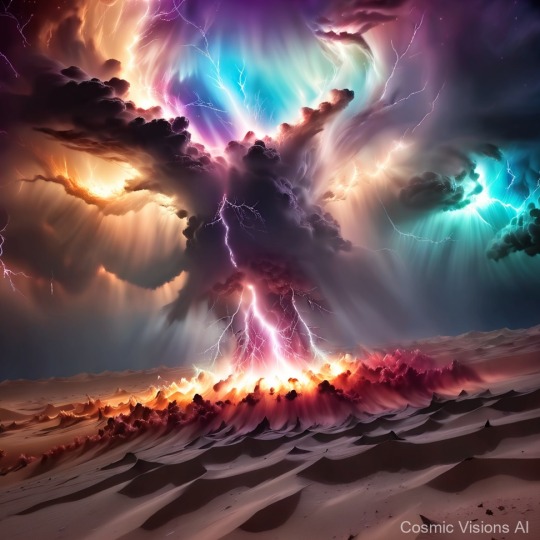


Planet Zephyria, known for its mesmerizing Crystal Rainbow Waterfalls, is a celestial body of immense beauty and wonder located in the distant Orianus star system. When viewed from orbit, Zephyria appears as a medium-sized planet with a diameter approximately 1.5 times that of Earth, shimmering with a multitude of colors that captivate the imagination. The planet's atmosphere is a delicate blend of gaseous compounds, including traces of iridescent gases that contribute to the stunning visual display observed from space. The predominant hues seen from above are hues of azure blue, emerald green, and amethyst purple, creating an ethereal ambiance that sets the stage for the extraordinary natural phenomena that unfold on its surface. Upon closer inspection, the surface of Zephyria reveals an otherworldly landscape dominated by vast expanses of crystal formations that refract light in a kaleidoscope of colors. These crystals are not merely decorative; they play a crucial role in the formation of the planet's renowned Crystal Rainbow Waterfalls. These magnificent waterfalls cascade down towering cliffs, their waters laced with mineral deposits that imbue them with a prismatic quality. As sunlight filters through the crystal-laden waters, rainbows dance and sway, creating a spectacle that is unparalleled in the known universe. The weather patterns on Zephyria are as dynamic as they are unpredictable. Due to the presence of crystalline formations across the planet, localized microclimates are formed, leading to sudden shifts in temperature and atmospheric conditions. Storms of crystal shards have been documented, where shards of varying sizes are propelled through the air by powerful gusts of wind, only to be eventually reabsorbed into the landscape. In addition to the Crystal Rainbow Waterfalls, Zephyria boasts other unique features, such as shimmering crystal caves that delve deep into the planet's core, revealing a network of subterranean channels filled with luminescent crystals that illuminate the caverns with an ethereal glow. These caves are thought to be interconnected, forming a complex underground ecosystem that sustains life forms yet to be fully documented by scientific expeditions. In conclusion, Planet Zephyria stands as a testament to the boundless creativity of the cosmos, a world where the elements of water, crystal, and light converge in a symphony of beauty and mystery. Its Crystal Rainbow Waterfalls are a testament to the wondrous forces of nature at play, inviting further exploration and discovery into the depths of its enigmatic landscapes.
#CrystalRainbowWaterfalls#SpaceArt#GalacticBeauties#NebulaMagic#CelestialWonders#AuroraDreams#DeepSpaceExploration#AstroPhotography#WonderousWorlds#StellarSpectacle
17 notes
·
View notes
Text
Туманность [Nebulamage]- это личность ксеногенератора, пол которого связан с туманностями и магами, маг, связанный с туманностями, или маг туманностей.Туманность является частью системы "gendermage".
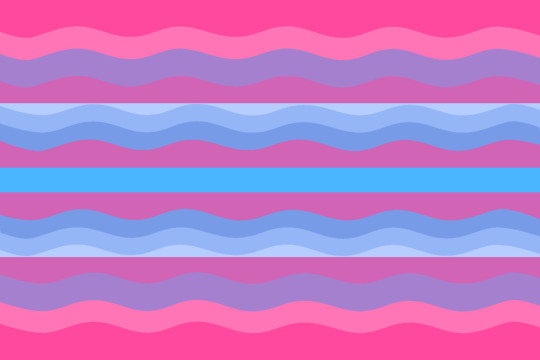
#русский тамблер#русский tumblr#русский пост#русский блог#трансгендер#lgbt#lgbtq community#transgender#lgbt флаг
1 note
·
View note
Text
Nebulamage
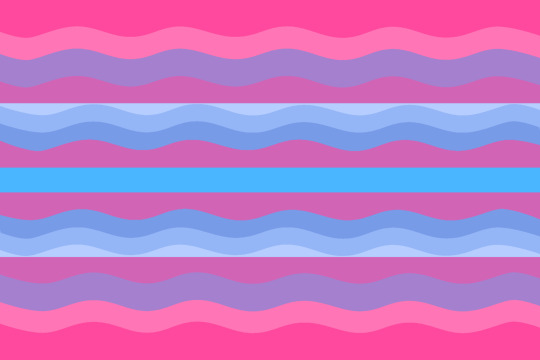
A gender connected to nebulae and mages, a mage associated with nebulae or a mage of nebulae.
#i have mastered the art of tearing convention apart ✨#mogai#liom#mogai coining#liom coining#mogai gender#liom gender#mogai orientation#liom orientation#mogai friendly#liom friendly#mogai safe#liom safe#xenogender#neogender#xenogender coining#neogender coining#gender coining#gendermage#nebulamage
18 notes
·
View notes
Photo
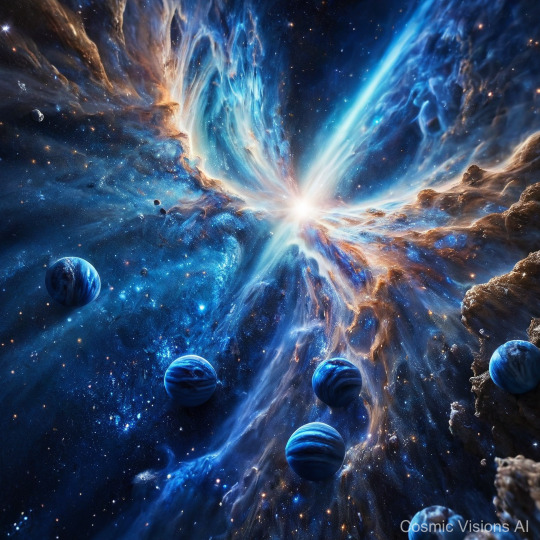
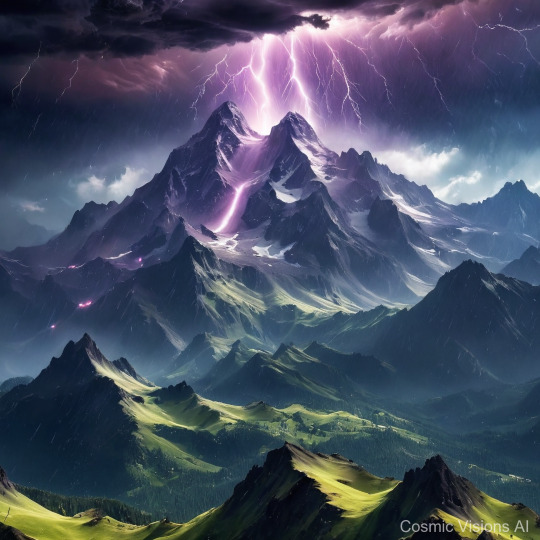
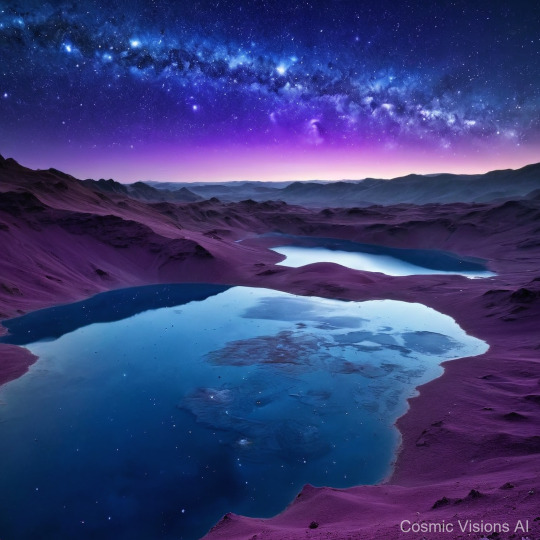
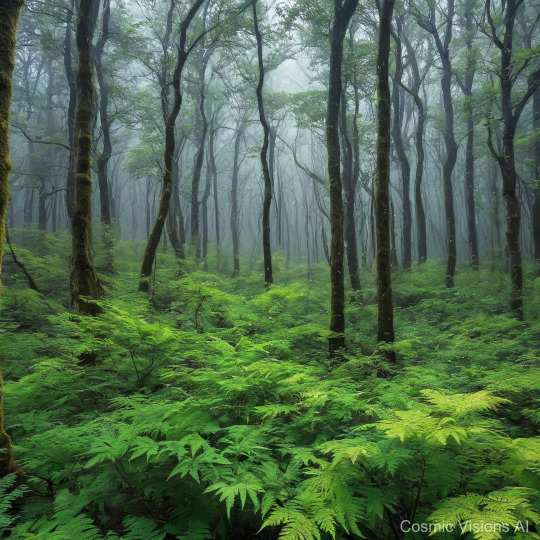
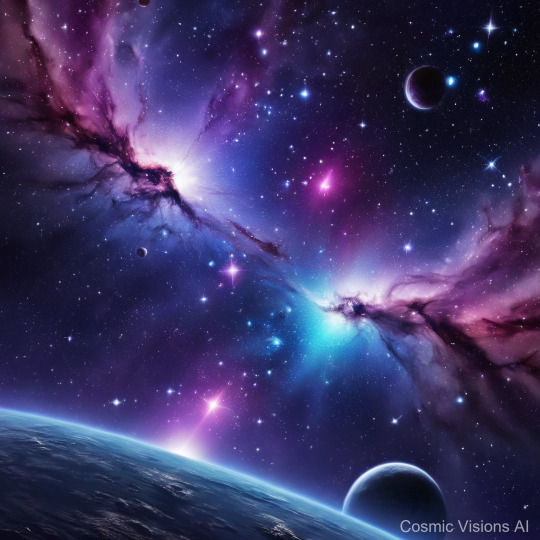
Planet Crystallon, observed from space, appears as a shimmering sapphire orb enveloped by thick, translucent clouds tinged with a faint amber hue. This exotic world is noted for its astonishing natural phenomenon: diamond rain showers. Scientific measurements suggest that the extreme pressure and temperature in Crystallon’s atmosphere convert carbon-rich gases into solid diamond crystals that precipitate dazzlingly onto the surface, enriching it with a sparkling, jewel-strewn landscape. The surface, visible during breaks in cloud cover, reveals vast plains of graphite dust and towering mountains capped with diamond—a surreal vision that mimics a frost-like sparkle under the dim, distant sunlight. These landscapes undergo periodic transformations as the diamond precipitation erodes and reshapes landforms. Notably, the atmosphere occasionally bursts with flashes of light as diamonds fall, creating a spectacle that contrasts sharply with the planet’s otherwise muted tones.
#DiamondRain#SpaceJewels#CelestialStorm#GalacticDownpour#AstronomyArt#StellarPhenomenon#SpaceDiamonds#CosmicShowers#NebulaMagic#AstroPhotography
0 notes
Photo
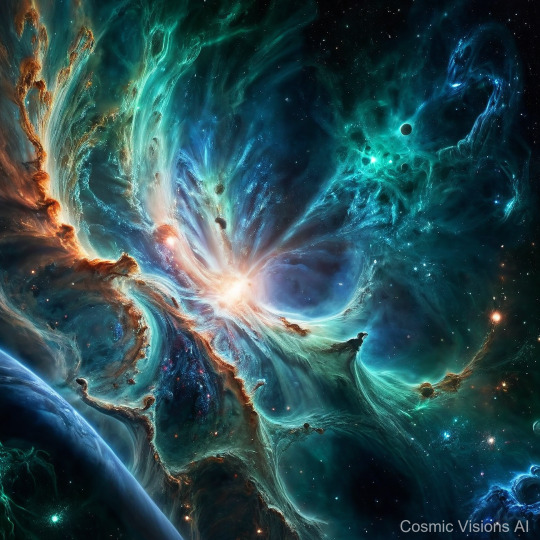
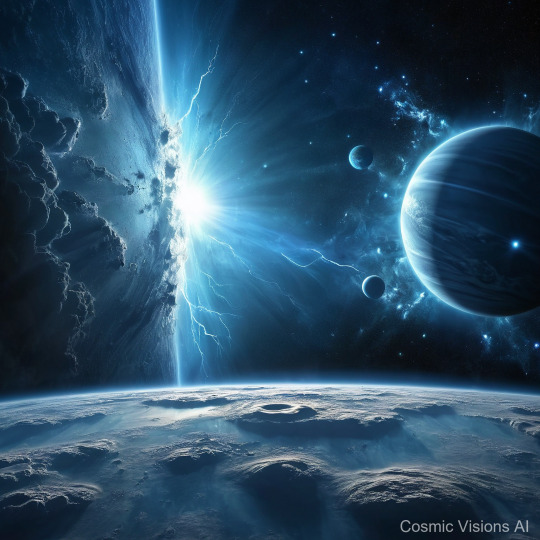
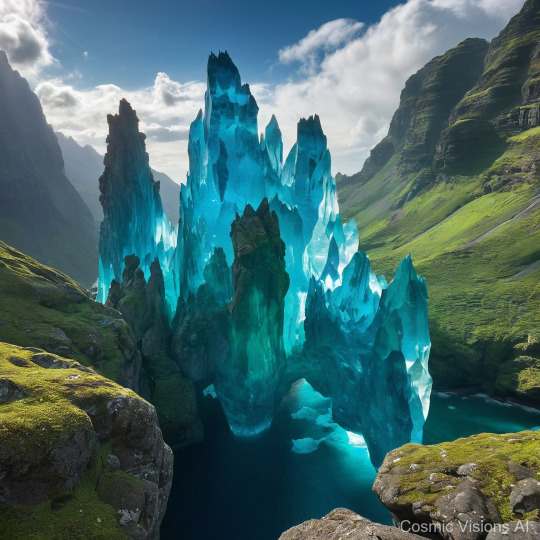
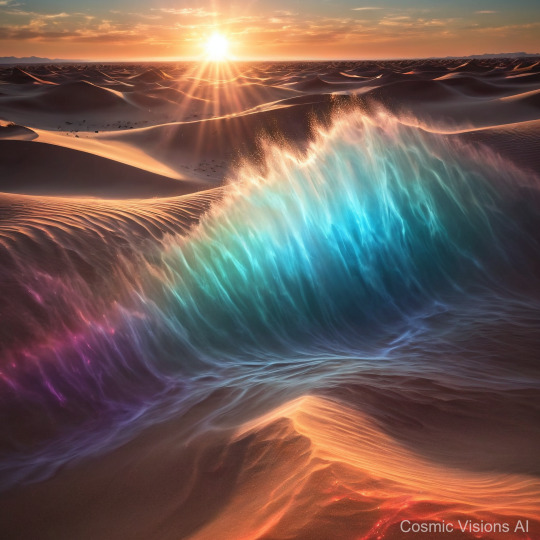
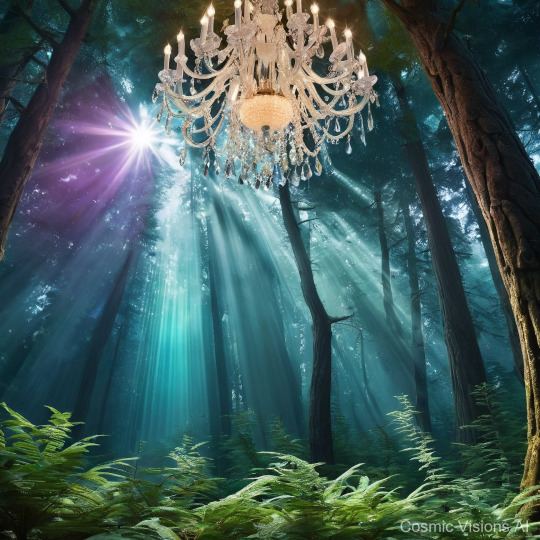
Planet Crystallon features an extraordinary atmosphere, dominated by 'Crystal Veil Clouds', which are composed of reflective silicate particles that shimmer brilliantly as they catch the starlight. This planet, slightly larger than Earth, glows softly from afar, its azure blue and silvery streaks creating an ethereal visual from orbit. These clouds have a metallic sheen, giving Crystallon an almost mirror-like appearance expanding across the globe. On its surface, Crystallon is riddled with vast, jagged landscapes of naturally formed crystal forests. These sparkling structures reflect not only the crystalline clouds above but also lend to extreme surface temperatures due to the heat retention properties of the silicate formations. The prevailing conditions are predominantly arid, with occasional bursts of crystal shard storms, where the high winds buffet against the fragile silicate, showering the ground with a stunning yet hazardous display of light and color. Crystallon’s extreme beauty is matched only by its potential for scientific study, holding secrets of mineral evolution and atmospheric phenomena.
#CrystalVeilClouds#DeepSpacePhotography#NebulaMagic#CelestialBeauty#GalacticWonder#AstronomyArt#SpaceNebulae#StarrySkies#CosmicFantasy#NebulaChasers
0 notes
Photo
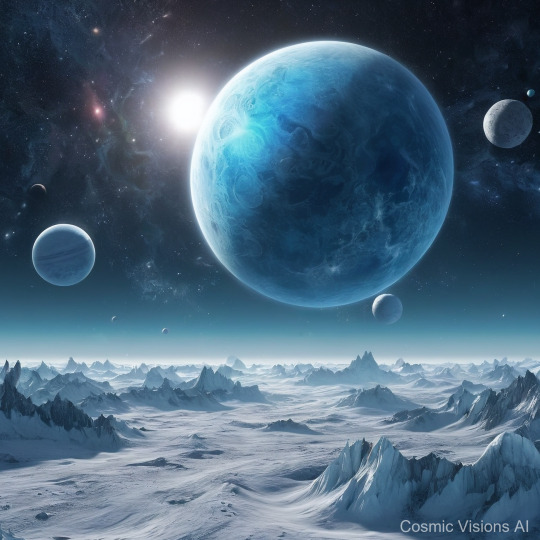
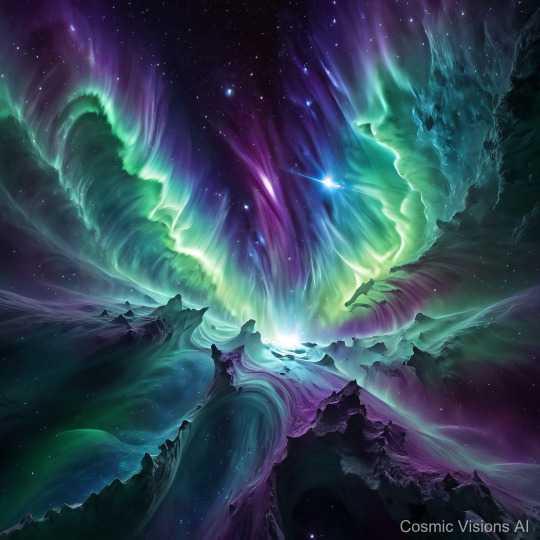
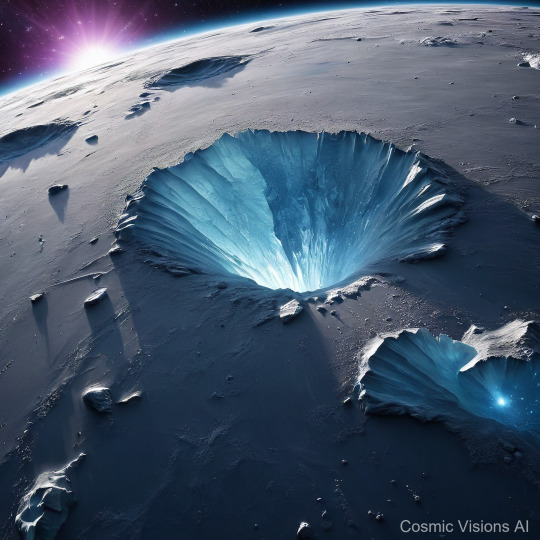
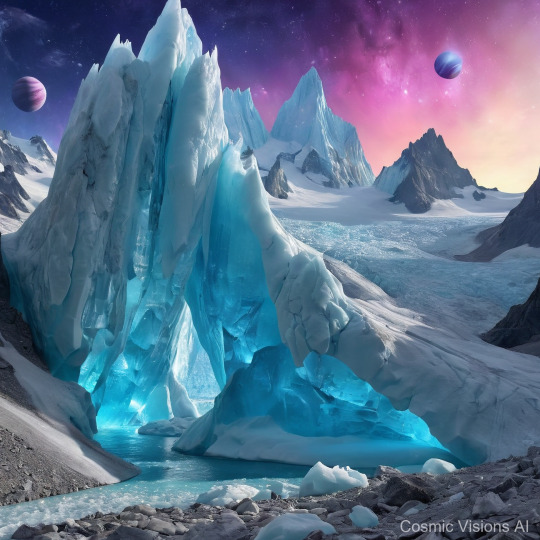
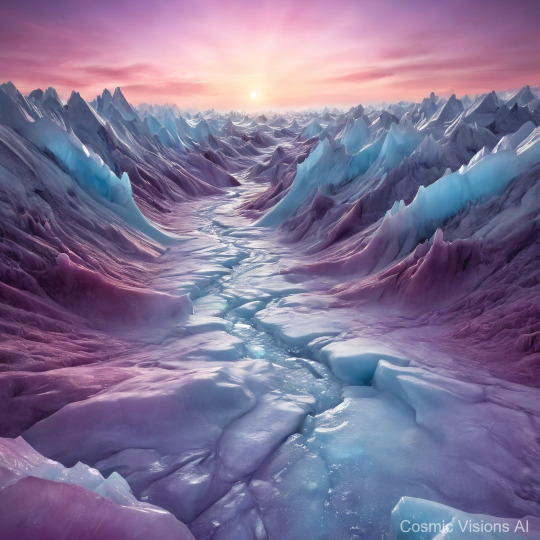
Planet Glaciaxion, observed from the cosmic expanse, reveals a striking azure and bluish-white palette, indicative of its vast icy surfaces and a thin, crisp atmosphere primarily composed of oxygen and argon. This orb, slightly smaller than Earth, is enveloped by swirling cloud formations that cast dynamic shadows across its frost-bound expanse. The surface of Glaciaxion is a spectacle of natural architecture, featuring towering glaciers predominantly composed of a unique, crystalline ice. This crystal, under the weak sunlight, whispers faintly as it expands and contracts, creating an eerie soundscape heard over the icy plains. The prevalent conditions include subzero temperatures and frequent, sharp winds that sculpt the ice into intricate formations resembling glass sculptures. These conditions have also formed deep crevasses and shimmering ice caverns, promising uncharted secrets beneath the frozen façade.
#WhisperingCrystalGlaciers#SpaceArt#GalacticIceFormations#CosmicPhotography#AstronomyArt#AstroArtistry#SpaceWhispers#CrystalGlacierWonders#StellarScenery#NebulaMagic
1 note
·
View note
Photo
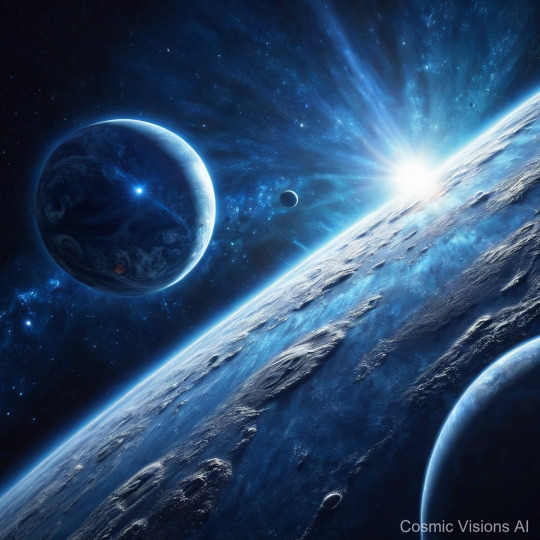
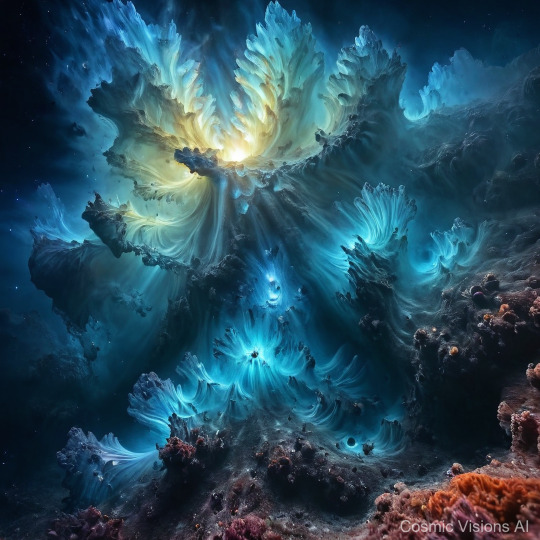
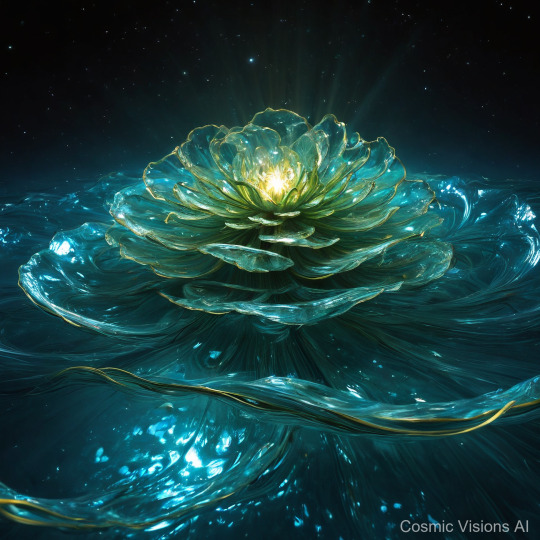
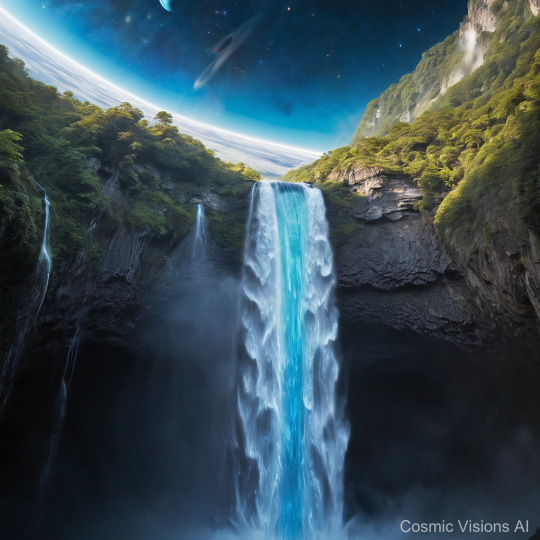
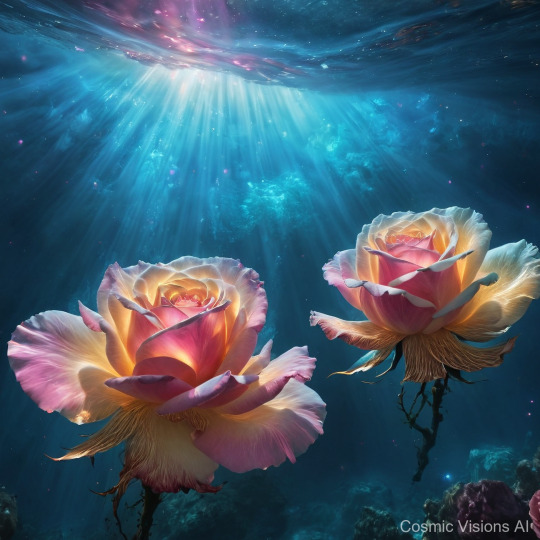
Planet Ocearix, visible from space as a radiant sapphire orb enveloped in swirling silver mists, boasts an extraordinary hydrological feature—its vast ocean depths are composed entirely of liquid crystal. This unique crystalline sea, shimmering with iridescent blues and greens, harbors complex, constantly shifting geometries beneath its surface. The crystal compounds not only dominate the aquatic landscape but also influence the atmospheric conditions, creating a perpetually luminous haze that blankets the planet. Ocearix’s surface remains cool and stable, with ambient temperatures hovering around 5 degrees Celsius, moderated by the high albedo of its icy crystal waters. Violent storms are common, fueled by the latent heat released from the crystallization processes in the deep sea, often resulting in spectacular lightning displays that dance across the sky, reflecting off the ocean below. Exploration from orbit suggests that these depths could harbor structures—either natural geological formations or perhaps something more anomalous, hinting at undisclosed secrets lying beneath the crystal waves.
#CrystalOceanDepths#SpacePhotography#AbyssalWorlds#GalacticWonders#DeepSpaceExploration#AstroArt#CosmicBeauty#InterstellarJourney#StarrySeas#NebulaMagic
1 note
·
View note
Photo

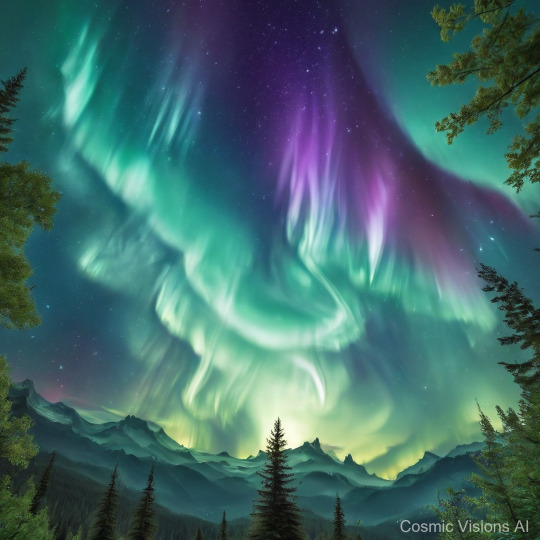
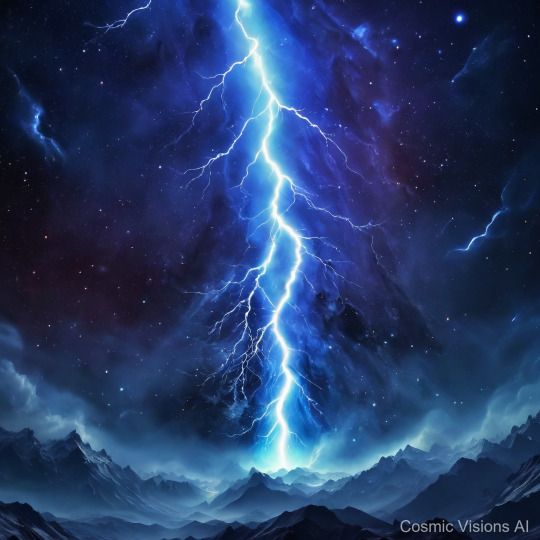
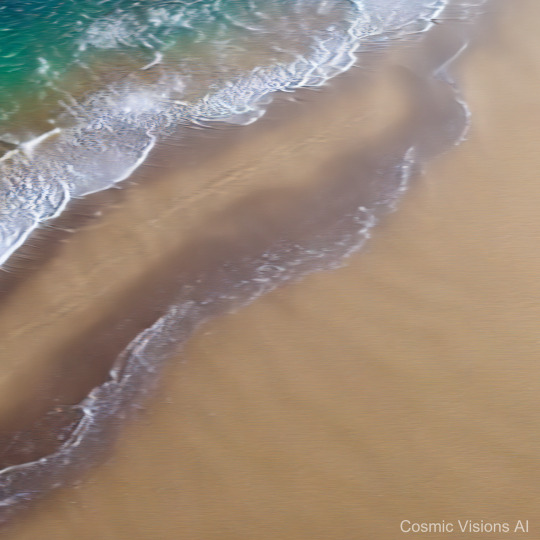

Planet Varidia, viewed from space, appears as a swirling mosaic of sapphire blue and shimmering greens, enveloped in thin veils of iridescent gases. Its most notable features include vast canyons of translucent crystals that catch the sunlight, casting an array of luminous colors visible even from orbit. The surface hosts the Whispering Aurora Forests, where bioluminescent foliage emits soft, pulsating lights and gentle sounds resembling soft whispers due to electrostatic phenomena in the atmosphere. Adjacent to these forests are the Silent Sandstorm Oceans, vast expanses of fine silicate particles constantly stirred by electromagnetic storms, creating an eerie, motion-blurred effect that contrasts starkly with the stillness of their sound. Dominating Varidia’s topography are the Thundering Sapphire Peaks. These immense mountains reflect a deep, jewel-tone blue and experience continuous seismic activities that sound like rolling thunder—echoes of the planet's vibrant geological life. Together, these features make Varidia a planet of both visual and auditory beauty, suggesting a rich tapestry of natural processes and atmospheric phenomena.
#IridescentCrystalCanyons#WhisperingAuroraForests#SilentSandstormOceans#ThunderingSapphirePeaks#GalacticWonders#CelestialScenes#CosmicDreams#HuesOfSpace#NebulaMagic#AstralBeauty
1 note
·
View note
Photo
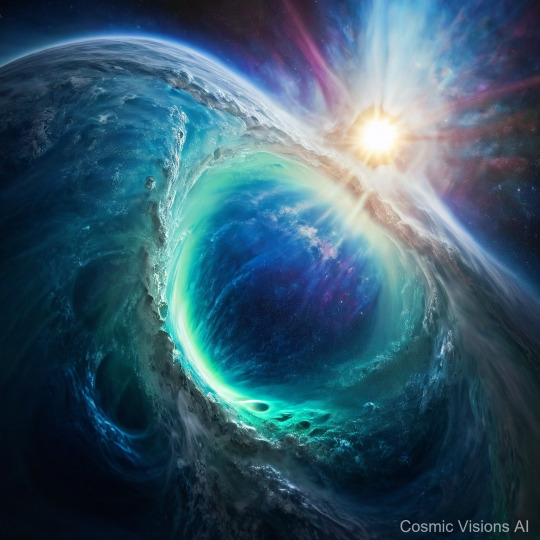
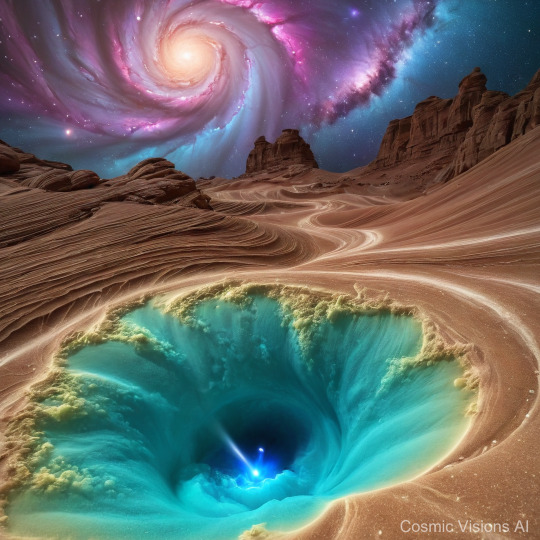
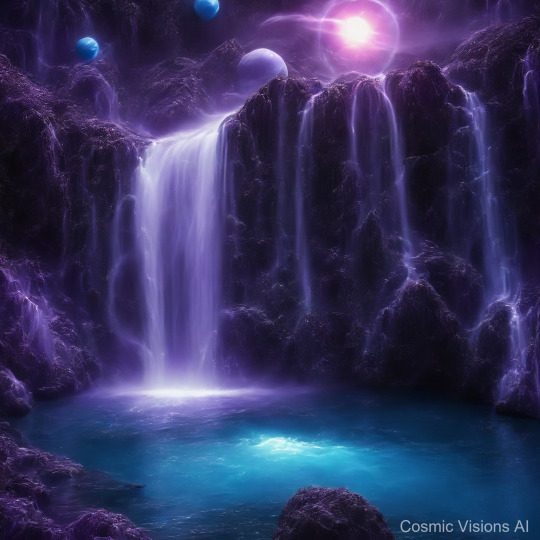
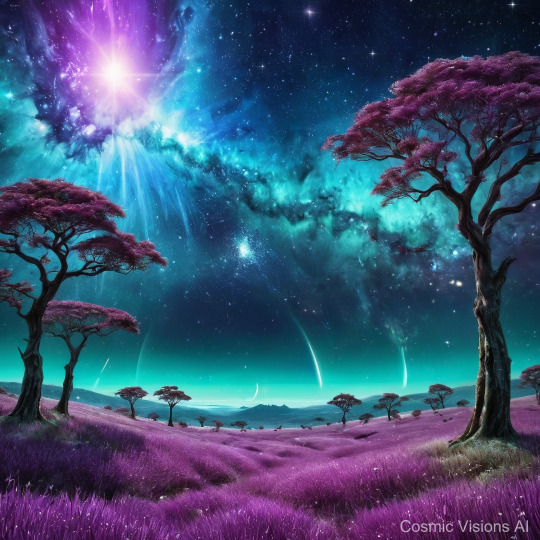
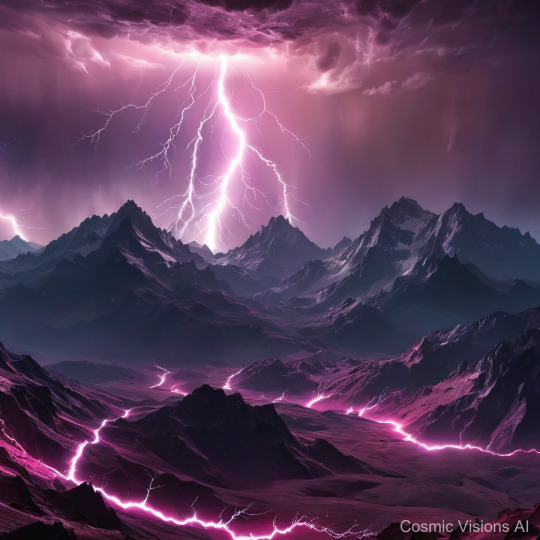
Planet Elyssia, designated P-417, reveals its unique allure from space through a translucent azure atmosphere and a surface sparkling with crystal sand seas. Situated in the Habrigar System, this smaller-than-Earth celestial body is dominated by expansive deserts of gleaming silica crystals, interspersed with rare, vibrant blue water oases. Elyssia’s atmosphere, thin and mostly composed of argon and nitrogen, offers stunning visual phenomena: prismatic skies resulting from the crystal-refracted sunlight. Surface exploration, though challenging in the abrasive, shifting sands, unveils the delicate balance of the planet’s ecosystem, maintaining moisture through nightly frosts that nourish oasis edges. These rare water sources, teeming with bioluminescent flora, stand in stark contrast to the stark, shimmering dunes surrounding them, creating a mesmerizing spectacle of light under Elyssia’s twin moons.
#CrystalSandOasis#SpaceDesert#GalacticOasis#StardustDreams#AstronomyArt#CelestialBeauty#CosmicWonders#OasisInSpace#StarSand#NebulaMagic
0 notes
Photo

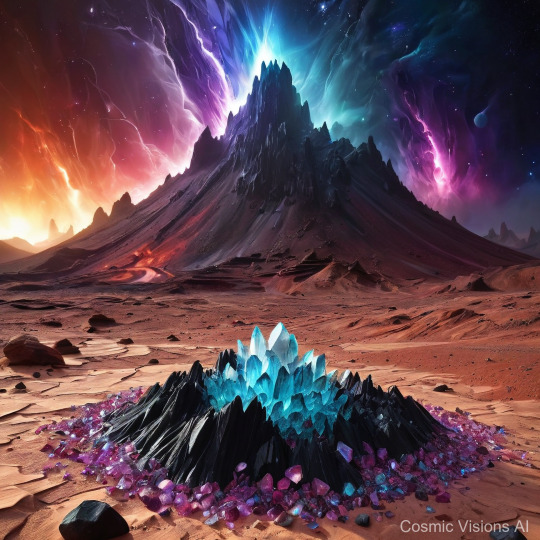
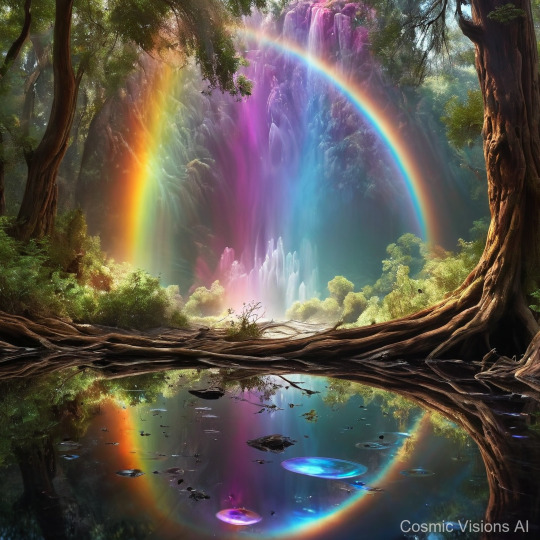
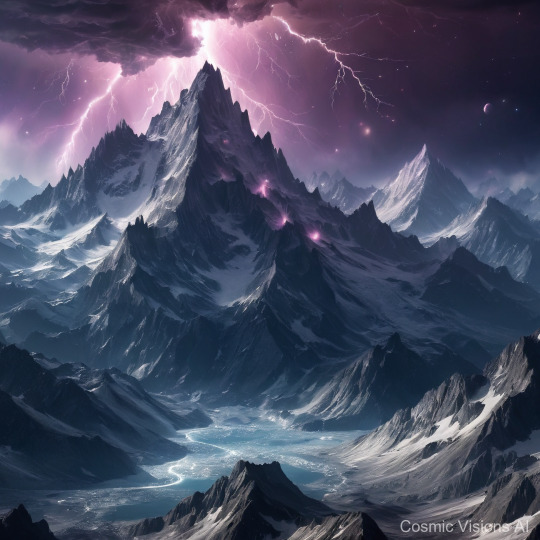
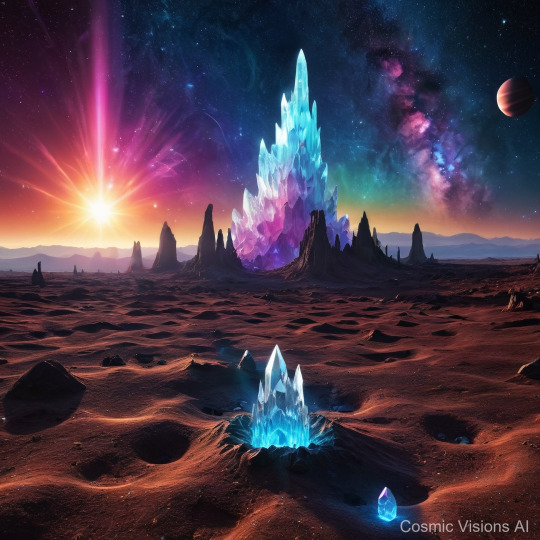
Planet Xypheron, distinctly visible from space, exhibits an intense azure glow, speckled with shimmering silver clouds—indicators of its silica-rich atmosphere. The surface, primarily composed of vast deserts of crystalline sand, reflects sunlight brilliantly, adding to its radiant appearance from orbit. Xypheron's most extraordinary phenomena are its periodic crystal storms, during which finely milled silicate particles are whipped into breathtaking cyclones by the planet's robust wind systems. These storms create temporary yet stunning oases, glistening in hues of cerulean and teal. The aftermath leaves landscapes dotted with intricate patterns of stacked crystals—an ephemeral beauty that morphs with each storm cycle. This unique interplay between fierce weather activity and tranquil aftermath defines Xypheron's dual nature as both tumultuous and serene.
#CrystalStormOasis#SpaceCrystals#GalacticVortex#AstronomyArt#NebulaMagic#StarryWonders#CelestialBeauty#CosmicExploration#InfiniteUniverse#SpaceAdventures
0 notes
Photo
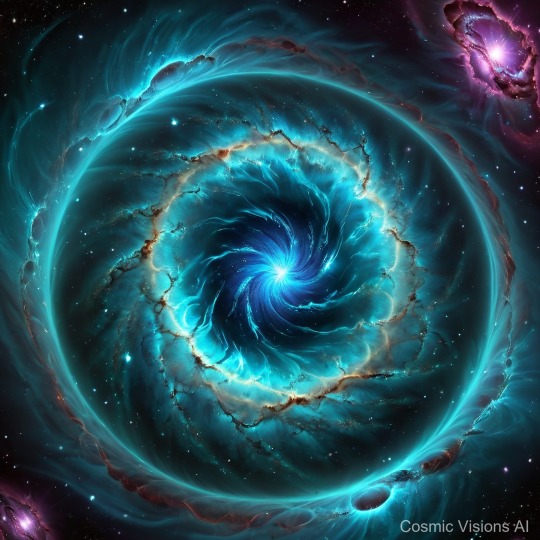
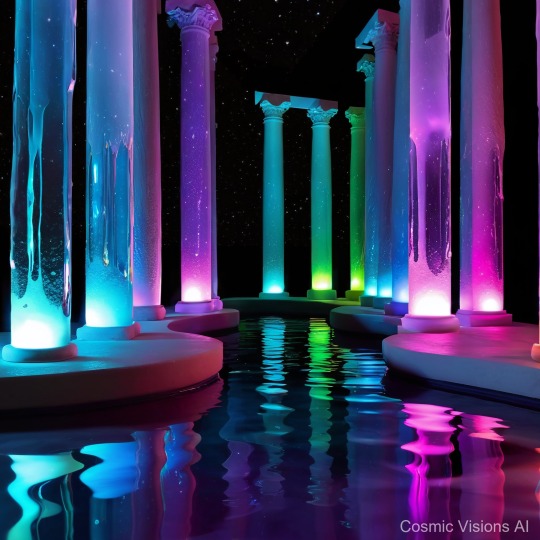
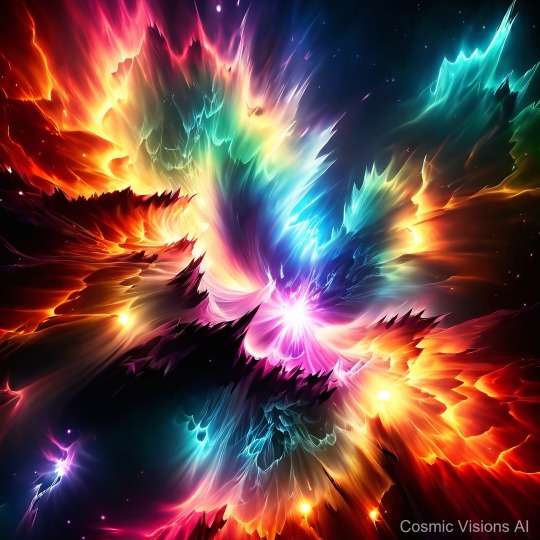

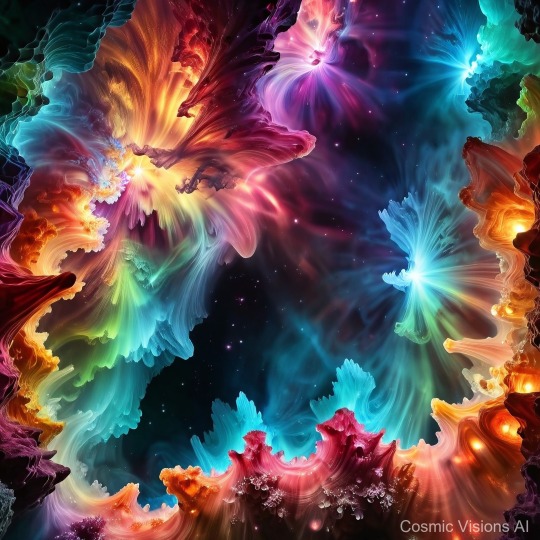
Galaxite-7, known for its mesmerizing glowing crystal landscapes, is encapsulated by a shimmering magenta-hued atmosphere. From the vantage of space, the planet appears as a radiant orb roughly the size of Neptune, its swirling gaseous envelope shimmering with bright streaks and speckles that suggest intense geological activity beneath. The surface of Galaxite-7 is dominated by vast planes of luminous crystals that emit a soft, pulsating glow, varying from electric blues to deep purples. These unique formations, likely composed of silicate minerals interlaced with bioluminescent compounds, cover much of the planet's topography. Weather patterns on the planet are equally striking; electrical storms frequently illuminate the crystal fields, creating a spectacle of light and color, while the thin atmosphere, composed largely of neon and argon, aids in the surreal luminosity observed during these tempests. This radiant planet offers a dazzling study in both geological and atmospheric sciences.
#GlowingCrystalParadiso#DeepSpaceBeauty#CosmicGems#AstronomyArt#GalacticWonder#CelestialCrystals#SpacePhotography#NebulaMagic#StellarSplendor#AstroArtistry
0 notes
Photo
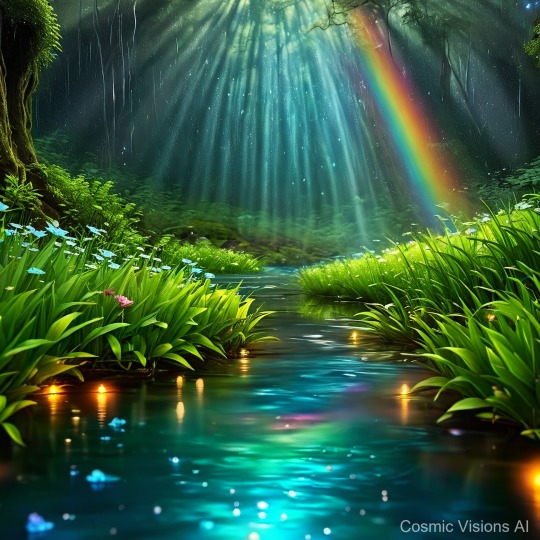

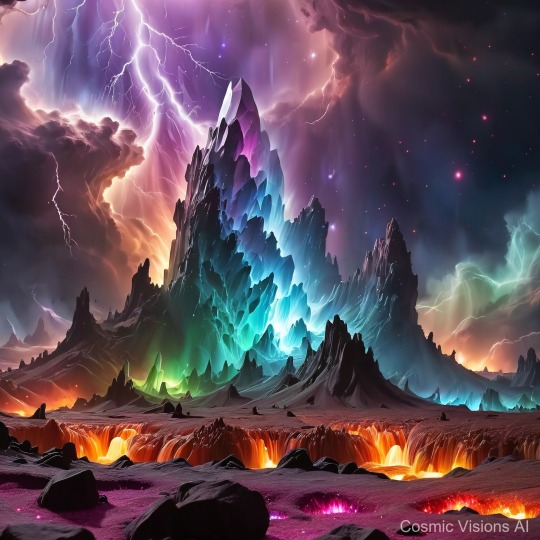
Planet Luminara, observed from space, reveals a striking azure glow, punctuated by swirling patterns of silver and gold—hints of its atmospheric iridescence. Approximately three-quarters the size of Earth, Luminara’s atmosphere is rich in silicate particles suspended in a hydrogen-helium mix, creating its unique, shimmering appearance. Surface exploration, as relayed through probes, shows a landscape dominated by vast crystal plains and towering spires. In the twilight of this planet, an extraordinary phenomenon occurs: iridescent crystal rainfall. These rainfalls emerge when the atmospheric temperature plummets, condensing the silicate vapors into shimmering, rainbow-hued crystals that gracefully descend upon the jagged terrain. This spectacle not only sculpts the planet’s surface with ever-changing layers of minerals but also contributes to its glimmering rivers, which flow like molten light under the alien sky.
#IridescentCrystalRainfalls#GalacticArt#CelestialBeauty#NebulaMagic#SpaceJewels#CrystalGalaxy#StellarVibrance#CosmicSplendor#AstronomyLife#UniverseWonders
1 note
·
View note
Photo

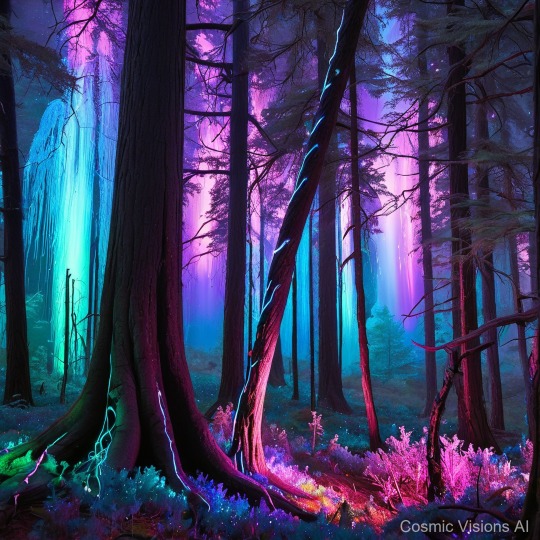


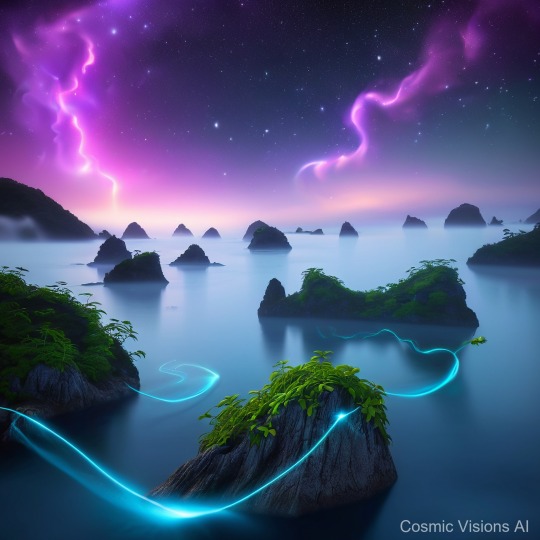
Planet Designation: Xytheria-9 From the vantage of orbit, Xytheria-9 presents a swirling enigma of cerulean and emerald hues, hinting at its dominant geographical feature: vast, crystal-infused rainforests that intertwine like veins across its surface. The planet, slightly smaller than Earth, possesses an atmosphere rich with nitrogen and oxygen, albeit with a higher humidity which attributes to frequent, shimmering mists that envelop much of the terrain. Surface analysis reveals that Xytheria-9's extraordinary forests boast an array of crystalline growths that emerge directly from the flora. These crystals, predominantly sapphire and emerald in color, appear to function akin to leaves, engaging in a photosynthetic process unique to this planet. The interplay of light and crystal creates a perpetual luminescence that underpins the forest canopy with an ethereal glow, particularly vivid during the Xytherian twilight. Meteorological patterns on Xytheria-9 are as captivating as its landscapes. The planet experiences what can be described as 'crystal rain,' a phenomenon where light precipitates, not as water, but as tiny, soft crystal shards that dissolve before accumulating on the ground. This crystal rain nourishes the soil, thereby supporting the incredible biodiversity of the rainforests. Temperature ranges from mild to warm, favorable for the growth of its dense biomes. Interestingly, the crystal structures contribute to a thermal regulation effect, reflecting excessive solar heat and retaining warmth during cooler periods. This thermal balance is critical in maintaining the lush, vibrant ecosystem observed. In summary, Xytheria-9 is a picturesque yet scientifically intriguing world where life, light, and crystal intermix seamlessly, offering a unique spectacle of natural beauty and ecological wonder.
#CrystalRainforestVeins#SpaceJungleVibes#GalacticFerns#NebulaMagic#AstroBotany#CelestialFoliage#StellarFantasy#CosmicGrove#InterstellarFlora#PlanetVeins
1 note
·
View note
Photo





Planet XJ-245 is a mesmerizing celestial body located in the distant reaches of the galaxy, captivating astronomers and researchers with its striking appearance. When viewed from space, the planet presents a remarkable sight—a medium-sized world with a diameter approximately 1.5 times that of Earth, enveloped in an ethereal glow of iridescent hues. Its predominantly azure surface is veiled in wisps of pearlescent clouds, hinting at a composition rich in unique elements that create this stunning visual display. The atmosphere of Planet XJ-245 is a fascinating study in itself. Comprised mainly of gaseous compounds such as ethereal xenon and traces of nitrogen, the atmosphere refracts light in such a way that it casts a perpetual rainbow glow across the planet's surface. This phenomenon, known as chromatic atmospheric dispersion, gives rise to the planet's iridescent appearance, captivating all who gaze upon it. Furthermore, the presence of crystalline particulates suspended in the air contributes to the scattering of light, enhancing the prismatic effect that bathes the planet in a kaleidoscope of colors. Beneath this captivating atmosphere lies the true marvel of Planet XJ-245—the crystal oceans that cover a significant portion of its surface. These iridescent bodies of liquid shimmer with a myriad of colors, ranging from opalescent whites to deep sapphire blues, creating a mesmerizing sight that is unparalleled in the known universe. The crystalline composition of these oceans is a result of unique geological processes that have taken place over millennia, causing the formation of mineral-rich waters that reflect and refract light in astonishing ways. As one delves deeper into the exploration of Planet XJ-245, its surface features reveal a landscape unlike any other. Vast crystalline formations tower towards the sky, catching and scattering light to create dazzling displays that dance across the horizon. Geometric patterns of iridescent minerals cover the ground, sparkling with otherworldly brilliance under the planet's ever-changing light conditions. The weather on Planet XJ-245 is volatile, with frequent crystal storms that send shimmering shards of prismatic light cascading through the atmosphere, adding to the planet's enigmatic allure. In conclusion, Planet XJ-245 stands as a testament to the beauty and complexity of the natural world, offering a spectacle that challenges our understanding of planetary phenomena. Its iridescent crystal oceans and vibrant atmosphere present a wealth of opportunities for further exploration and scientific inquiry, beckoning interstellar researchers to uncover the mysteries that lie within its shimmering depths.
#IridescentCrystalOceans#SpacePhotography#GalacticBeauty#NebulaMagic#StardustWonders#CelestialWaves#DeepSpaceGems#CosmicDreamscape#UniverseReflections#AstronomyInspiration
0 notes
Text
Galaxymage
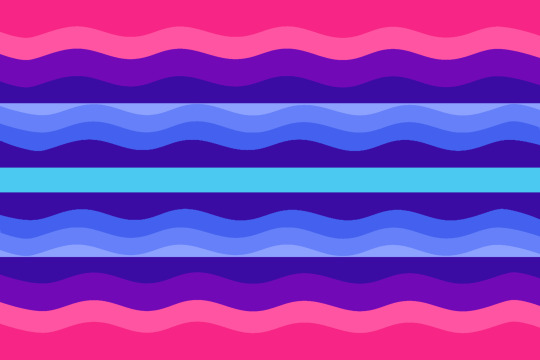
A gender connected to galaxies and mages, a mage associated with galaxies or a mage of galaxies.
#i have mastered the art of tearing convention apart ✨#mogai#liom#mogai coining#liom coining#mogai gender#liom gender#mogai orientation#liom orientation#mogai friendly#liom friendly#mogai safe#liom safe#xenogender#neogender#xenogender coining#neogender coining#gender coining#gendermage#nebulamage
15 notes
·
View notes